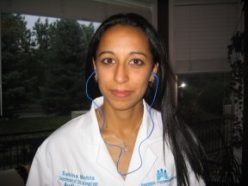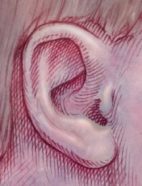Scientist’s Notebook
 |
| Sabina Mehta is an expert in diagnosing and treating hearing problems. |
| E. Sohn |
“In order for her to detect sound without a hearing aid,” Mehta says, “it has to be louder than a vacuum cleaner.”
As she watched her mother struggle to hear, Mehta became more and more interested in learning how ears work. After college, she studied to become an audiologist—an expert in diagnosing and treating hearing problems.
Her training involved testing the ears of newborns and educating people about hearing loss. Now, she works at a hospital in Denver, where she fits people with hearing aids, among other tasks.
One of the most interesting things about ears, Mehta says, is that even though they look funny, they are shaped that way for a reason. Every curve and bend helps boost the quality of sounds we hear.
“You wonder why there are all those contortions and strange dips and rises,” she says. “They’re really goofy looking. Even cats ears are shaped funny.”
 |
|
An ear’s contorted shape helps it capture sound waves and improve the quality of the sounds that we hear. |
Mehta is also fascinated by the connection between hearing and language.
“One thing that’s really neat is that there is a range of frequencies most speech falls in, and we hear best in that range,” she says. “It’s a chicken or egg thing. Did we develop ears like this to hear human speech? Or did human speech fall in to the resonance of our ears?”
Mehta enjoys being an audiologist because she likes working with people, she is interested in science, health is important to her, and she feels that she’s making a difference. The only downside is that hearing-aid patients aren’t easy to satisfy. That’s because hearing aids don’t actually correct hearing. They simply help any remaining hair cells amplify sounds.
Mehta has come to value her own hearing enough that she works hard to protect it. She wears earplugs when she vacuums, when she goes to action movies, and when the TV is on too loud. She knows that most people, however, do not take the same precautions.
“We live in a society where people want to feel it,” she says, and these are habits that won’t die easily. “They want to feel the game. They want surround sound. It’s so damaging. As much as I’d like to think that handing out earplugs would make a difference, I think that kids would use them for a little while and then forget.”
The only way to prevent rampant hearing loss in our society, she thinks, is to pass laws that require noises to be kept below a certain level. Eighty decibels or lower is a safe level she says. The Xbox in her 13-year-old stepson’s bedroom, however, regularly tops 120 decibels.
“It’s like a jet plane in there,” she says.
People need to take responsibility for their own ears. But, until they do, Mehta should have plenty of work to keep her busy.—E. Sohn